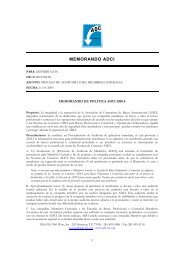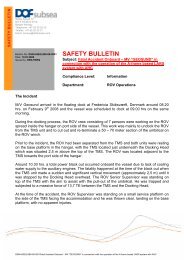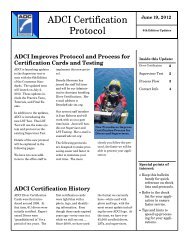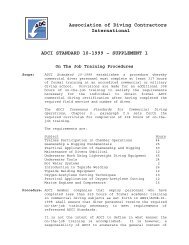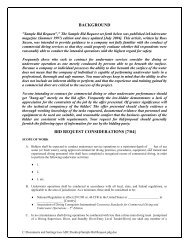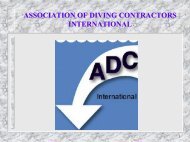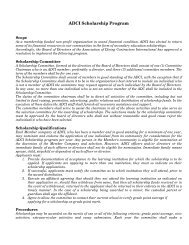DIRECTIVE NUMBER: CPL 02-00-151 EFFECTIVE DATE ... - OSHA
DIRECTIVE NUMBER: CPL 02-00-151 EFFECTIVE DATE ... - OSHA
DIRECTIVE NUMBER: CPL 02-00-151 EFFECTIVE DATE ... - OSHA
You also want an ePaper? Increase the reach of your titles
YUMPU automatically turns print PDFs into web optimized ePapers that Google loves.
from the second-stage regulator, which can result in asphyxiation of the diver.<br />
Regulators authorized by the U.S. Navy are for use only in the specified configuration.<br />
Consequently, the use of a second-stage SCUBA regulator independent of the first-stage SCUBA<br />
regulator is not approved by the Navy. Also, Navy approval is for Navy equipment used in Navy<br />
diving operations; this approval does not extend to the use of such equipment by commercial<br />
divers or other organizations.<br />
Question #8: Are employers in compliance with <strong>OSHA</strong> standards when they rely on<br />
employees who own their own diving equipment to maintain this equipment<br />
Answer: <strong>OSHA</strong> supports and encourages employees to maintain, inspect, and ensure the safe<br />
operation of the equipment that they own and use in their employers’ diving operations.<br />
However, these actions do not relieve employers of their responsibilities under <strong>OSHA</strong> standards<br />
to ensure the proper use, maintenance, testing, and other required actions regarding diving<br />
equipment used in the course of employment. Accordingly, <strong>OSHA</strong> makes no distinction<br />
between “employer-owned” equipment and “employee-owned” equipment. If the equipment is<br />
not in compliance with <strong>OSHA</strong> standards, and it is being used in the course of employment, then<br />
the employer is in violation of the standards.<br />
Question #9: When a decompression chamber is not available at the dive location, can<br />
employers administer 1<strong>00</strong> percent oxygen to a diver who experiences decompression<br />
sickness or arterial gas embolism while the diver is being transported to a decompression<br />
chamber Can an oxygen mask with a mouthpiece-held demand inhalator valve be used<br />
for unconscious patients<br />
Answer: <strong>OSHA</strong> standards require a multi-place recompression chamber at the dive location for<br />
any planned decompression dive, any dive deeper than 1<strong>00</strong> fsw, or any dive on a breathing<br />
medium other than standard air. However, divers who are not covered by these recompression<br />
chamber requirements (such as conducting no-decompression dives less than 1<strong>00</strong> fsw) can incur<br />
decompression sickness (i.e., “bends”) or an arterial gas embolism. In these situations, when no<br />
recompression chamber is immediately available, the following guidelines apply. When<br />
transporting a breathing diving patient from the dive location to an available chamber for<br />
treatment, or when transporting any other breathing diving patient from one treatment facility to<br />
another, a portable oxygen supply consisting of an E cylinder (approximately 669 liters of<br />
oxygen) and a transparent mask is recommended. When transporting a non-breathing diving<br />
patient from the dive location to an available chamber for treatment, a mechanical-bag<br />
resuscitator with a pure oxygen supply is recommended; the oxygen supply should be<br />
administered only by trained personnel. Under these circumstances, <strong>OSHA</strong> does not recommend<br />
the use of an emergency-oxygen kit having a replacement oxygen mask with a mouthpiece-held<br />
demand inhalator valve, because it is not suitable for an unconscious patient, and oxygen is<br />
incompatible with the rubber parts of the mouthpiece assembly.<br />
Although the use of pure-oxygen treatment for a diving patient may be beneficial, it is not a<br />
substitute for recompression treatment. When a diver incurs any diving illness that requires<br />
recompression treatment (such as decompression sickness, or arterial gas embolism), the diver<br />
must be treated at a recompression facility. Oxygen treatment may be necessary or desired<br />
A-5


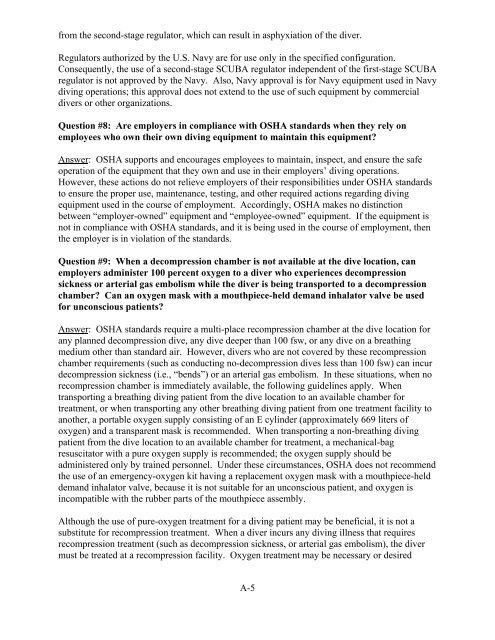
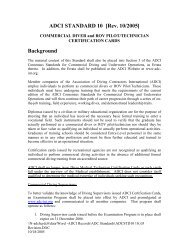
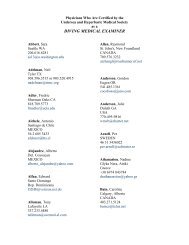
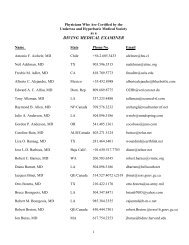
![SOLICITUD MEMBRESIA ASOCIADO [Rev 06/08] - Association of ...](https://img.yumpu.com/48291988/1/190x245/solicitud-membresia-asociado-rev-06-08-association-of-.jpg?quality=85)

